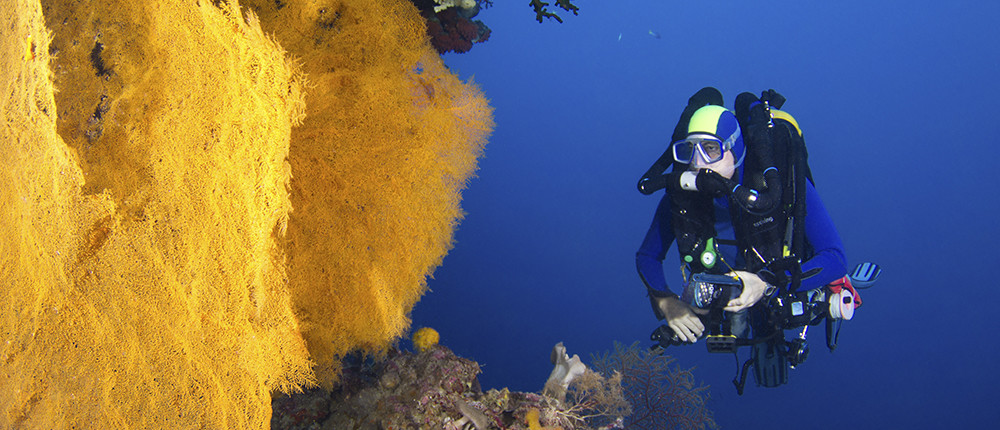A CCR Experience Without Equal
Reaping the benefits of closed-circuit scuba at Wakatobi Dive Resort
With more than 20 kilometers of protected reef to explore, most visitors to Wakatobi find they run out of bottom time long before they run out of things to see. Short of growing gills, one of the best ways to rack up a bit more underwater exploration is to dive with a rebreather. In recent years, the popularity of closed-circuit rebreathers, aka CCR, has continued to increase among the recreational diving community. There are a number of advantages rebreathers provide, including the possibility of increased no-stop bottom times, the unit’s ability to deliver warmer, moister breathing gas, and the benefits of silent operation, which may allow closer approaches to marine life.
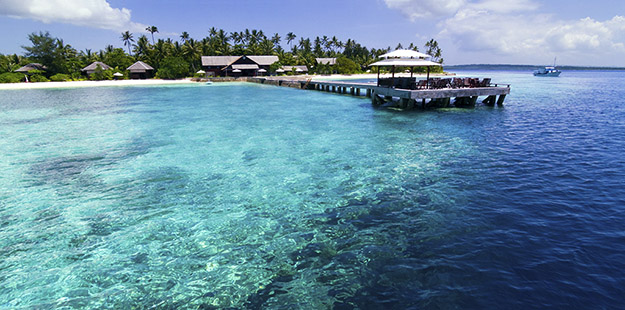
Wakatobi’s house reef is ideal for rebreather diving. Divers have the option to enjoy extended CCR dives mere steps away from the beach fronting the resort’s villas and bungalows. Photo by Walt Stearns
An ideal setting
In many ways, Wakatobi is an ideal location for rebreather diving. The same high-relief reefs that allow open-circuit scuba divers to enjoy long multi-level dives are perfect for rebreather profiles, as divers can begin with an investigation of the deeper portions of the sites, then perform gradual hour-plus ascents to depths of five meters or less, enjoying spectacular scenery and abundant marine life the entire dive while incurring little or no decompression obligation. A rebreather’s lack of exhalation bubbles also provides advantages when viewing the many rare small and sometimes shy animals found on Wakatobi’s reefs.
“Initially, we had some reservations about bringing rebreathers to a remote location such as Wakatobi. But their staff was more than able to provide the necessary support and supplies we required. As with the rest of our Wakatobi experience, there were no problems, and the diving was amazing!” ~Josh Thornton
The only downside that many rebreather divers may cite is the difficulty of finding the supplies and support needed for operation. To accommodate closed-circuit divers, a resort has to stock absorbent medium, oxygen fills, supply cylinders and bailout tanks, all administrated by a staff that understands the protocols and altered dive profiles a rebreather creates. Diving itineraries may also need to be modified to accommodate the typically longer bottom times CCR diving provides. Fortunately, there are a growing number of dive resorts now catering to the needs of closed-circuit divers, and Wakatobi is at the head of this list. Here, rebreather divers are provided not only the support structure their equipment requires, but also enjoy a marine environment that is ideally suited to maximizing the in-water benefits of rebreathers.
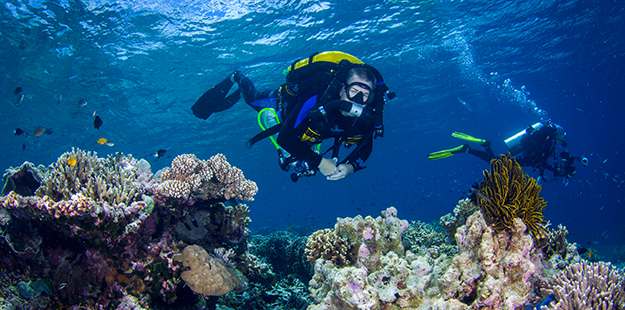
At Wakatobi rebreather divers are provided not only the support structure their equipment requires, but also enjoy a marine environment that is ideally suited to maximizing the in-water benefits of rebreathers. Photo by Steve Miller
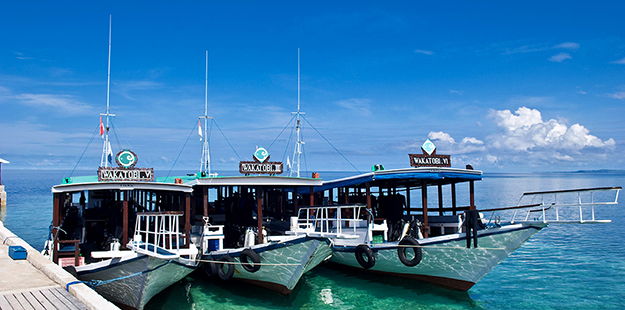
To facilitate their diving activity, the Silent World dive group was provided with their own boat, which allowed them to make longer dives without keeping open-circuit divers waiting. Photo by Warren Baverstock
Craig Willemsen, the owner of Silent World Diving in Bellevue, Washington, has led several rebreather trips to Wakatobi. “Many on the last trip were diving the KISS Sport or the Orca Spirit, and a couple had Evolutions,” he says. “Most of the group packed all their gear in a carry on and two regular 50-pound checked bags, or in the case of the Evolutions, 70 pounds. There’s really no problem traveling with a rebreather if you pack things correctly.”
Daily diving activity is also a smooth process for CCR divers at Wakatobi, Willemsen reports. “The dive staff at Wakatobi is very rebreather savvy. They understand the equipment and the profiles, and several of them are avid closed-circuit divers themselves.” To facilitate their diving activity, his group was provided with their own boat, which allowed them to make longer dives without keeping open-circuit divers waiting.
A pioneer program
Wakatobi’s closed-circuit rebreather diving program was among the first in the Indo-Pacific region, dating back to 2006. Soon after resort founder Lorenz Mader purchased his first AP Evolution CCR, he realized the need to invest in the systems required to support closed circuit diving. The dive shop was equipped with gas booster pumps, and stocked with Sofnolime absorbent, two- and three-liter supply tanks in both steel and aluminum, and an assortment of off board bailout tanks and regulators. The resort’s oxygen supply was increased, and arrangements were put in place for the delivery of helium to support trimix diving. Currently, there are three certified Advanced Gas Blenders on the dive staff.
New dive protocols and boat schedules were also created to accommodate CCR diving schedules. On many trips, CCR divers are paired with a dive guide who is also CCR qualified, and who will accompany the dive team through an extended profile. Even on those occasions when CCR-qualified guides are not available, the dive team can create a dive plan that allows CCR divers to enjoy extended bottom times with guides on open circuit equipment who split their services into two shifts.
Larger CCR groups are often assigned their own boat, allowing them to take maximum advantage of the silent diving experience and enjoying the full freedom the technology allows. Currently, the resort maintains ample supplies of Sofnolime 797 (8-12 mesh) and N2050 (4-8 mesh) to support up to 15 CCR divers at all times, and even larger groups can be accommodated with advanced notice. Cartridge absorbent can also be provided given sufficient lead time to ensure shipping.
“We took a group of 16 divers to Wakatobi and had a great time,” says Josh Thornton of Dive Addicts in Draper, Utah. “The dive staff and resort staff were pleasant and eager to provide great service. There were no problems whatsoever providing oxygen and sorb, and I would not hesitate to take a larger group of CCR divers back to the resort -in fact we are looking at planning a CCR-only trip in 2017. You may need to arrange the support before your trip, but let them know what you need and they will find a way to provide it!”

Daily diving acitivity is a smooth process for CCR divers at Wakatobi,” says Craig Willemsen.” The dive staff understand the equipment and the profiles, and several are avid closed-circuit divers themselves,” he says. Photo by Didi Lotze
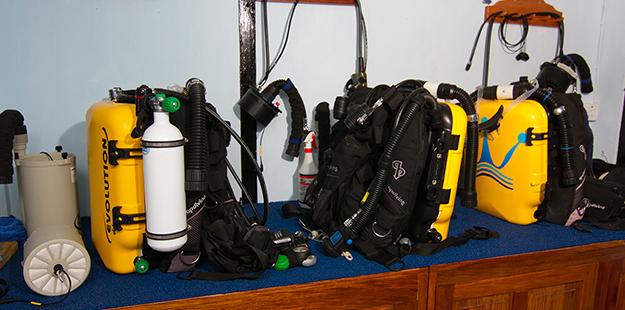
CCR divers have a separate arrangement for setting up and maintaining their systems. Photo by Walt Stearns
CCR diving is also available aboard Wakatobi’s liveaboard dive yacht, the Pelagian – but only upon advance request of four months with Wakatobi’s administrative offices in Bali. Because diving activity on Pelagian is conducted from the ship’s tenders, diving a rebreather from these smaller boats requires a higher degree of fitness and comfort with the equipment than would be the case aboard the resort’s large day boats. In addition, because gear space aboard the tenders is limited on trips when the Pelagian is filled to capacity, CCR diving at such time would be limited to a single off-board configuration rather than the more complex rigging needed to stage extended decompression or trimix dives.


